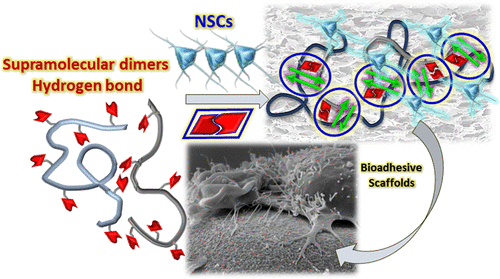当前位置:
X-MOL 学术
›
Biomacromolecules
›
论文详情
Our official English website, www.x-mol.net, welcomes your
feedback! (Note: you will need to create a separate account there.)
Adhesive Sponge Based on Supramolecular Dimer Interactions as Scaffolds for Neural Stem Cells.
Biomacromolecules ( IF 5.5 ) Pub Date : 2020-06-25 , DOI: 10.1021/acs.biomac.0c00825 Luanda Lins 1 , Florence Wianny 2 , Colette Dehay 2 , Jacques Jestin 3 , Watson Loh 1
Biomacromolecules ( IF 5.5 ) Pub Date : 2020-06-25 , DOI: 10.1021/acs.biomac.0c00825 Luanda Lins 1 , Florence Wianny 2 , Colette Dehay 2 , Jacques Jestin 3 , Watson Loh 1
Affiliation

|
Improving cell-material interactions of nonadhesive scaffolds is crucial for the success of biomaterials in tissue engineering. Due to their high surface area and open pore structure, sponges are widely reported as absorbent materials for biomedical engineering. The biocompatibility and biodegradability of polysaccharide sponges, coupled with the chemical functionalities of supramolecular dimers, make them promising combinations for the development of adhesive scaffolds. Here, a supramolecular tactic based on (UPy)-modified polysaccharide associated with three-dimensional structure of sponges was developed to reach enhanced cellular adhesion. For this purpose, three approaches were examined individually in order to accomplish this goal. In the first approach, the backbone polysaccharides with noncell adhesive properties were modified via a modular tactic using UPy-dimers. Hereupon, the physical–chemical characterizations of the supramolecular sponges were performed, showing that the presence of supramolecular dimers improved their mechanical properties and induced different architectures. In addition, small-angle neutron scattering (SANS) measurements and rheology experiments revealed that the UPy-dimers into agarose backbone are able to reorganize in thinning aggregates. It is also demonstrated that the resulted UPy-agarose (AGA-UPy) motifs in surfaces can promote cell adhesion. Finally, the last approach showed the great potential for use of this novel material in bioadhesive scaffolds indicating that neural stem cells show a spreading bias in soft materials and that cell adhesion was enhanced for all UPy-modified sponges compared to the reference, i.e. unmodified sponges. Therefore, by functionalizing sponge surfaces with UPy-dimers, an adhesive supramolecular scaffold is built which opens the opportunity its use neural tissues regeneration.
中文翻译:

基于超分子二聚体相互作用作为神经干细胞支架的粘性海绵。
改善非粘性支架的细胞-材料相互作用对于生物材料在组织工程中的成功至关重要。由于海绵的高表面积和开孔结构,海绵被广泛报道为生物医学工程的吸收材料。多糖海绵的生物相容性和可生物降解性,再加上超分子二聚体的化学功能,使其成为开发粘性支架的有前途的组合。在这里,基于与海绵的三维结构相关联的(UPy)-修饰的多糖的超分子策略被开发以达到增强的细胞粘附性。为此目的,分别研究了三种方法以实现该目标。在第一种方法中 通过使用UPy-二聚体的模块化策略对具有非细胞粘附特性的主链多糖进行了修饰。此后,进行了超分子海绵的物理化学表征,表明超分子二聚体的存在改善了它们的机械性能并诱导了不同的结构。此外,小角度中子散射(SANS)测量和流变学实验表明,进入琼脂糖骨架的UPy-二聚体能够在稀疏聚集体中重组。还证明了所得的表面上的UPy-琼脂糖(AGA-UPy)基序可以促进细胞粘附。最后,最后一种方法显示了在生物粘附支架中使用这种新型材料的巨大潜力,这表明神经干细胞在柔软的材料中表现出扩散偏差,并且与未改性的海绵相比,所有UPy改性的海绵均增强了细胞粘附性。因此,通过用UPy-二聚体对海绵表面进行功能化,可以构建一种粘性的超分子支架,从而为利用神经组织再生提供了机会。
更新日期:2020-08-10
中文翻译:

基于超分子二聚体相互作用作为神经干细胞支架的粘性海绵。
改善非粘性支架的细胞-材料相互作用对于生物材料在组织工程中的成功至关重要。由于海绵的高表面积和开孔结构,海绵被广泛报道为生物医学工程的吸收材料。多糖海绵的生物相容性和可生物降解性,再加上超分子二聚体的化学功能,使其成为开发粘性支架的有前途的组合。在这里,基于与海绵的三维结构相关联的(UPy)-修饰的多糖的超分子策略被开发以达到增强的细胞粘附性。为此目的,分别研究了三种方法以实现该目标。在第一种方法中 通过使用UPy-二聚体的模块化策略对具有非细胞粘附特性的主链多糖进行了修饰。此后,进行了超分子海绵的物理化学表征,表明超分子二聚体的存在改善了它们的机械性能并诱导了不同的结构。此外,小角度中子散射(SANS)测量和流变学实验表明,进入琼脂糖骨架的UPy-二聚体能够在稀疏聚集体中重组。还证明了所得的表面上的UPy-琼脂糖(AGA-UPy)基序可以促进细胞粘附。最后,最后一种方法显示了在生物粘附支架中使用这种新型材料的巨大潜力,这表明神经干细胞在柔软的材料中表现出扩散偏差,并且与未改性的海绵相比,所有UPy改性的海绵均增强了细胞粘附性。因此,通过用UPy-二聚体对海绵表面进行功能化,可以构建一种粘性的超分子支架,从而为利用神经组织再生提供了机会。










































 京公网安备 11010802027423号
京公网安备 11010802027423号